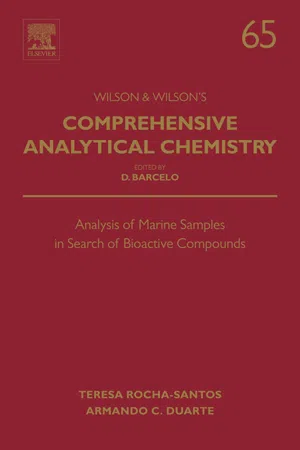
- 312 pages
- English
- ePUB (mobile friendly)
- Available on iOS & Android
About This Book
Seas and oceans offer a wide range of temperature, pressure, light and chemical conditions thus allowing a wide diversity of marine organisms from shallow coastal waters to the deep ocean. These resources can be used to obtain new products and develop services, and in turn help to provide solutions to the challenges that affect our planet, including offering a sustainable supply of food and energy, new industrial materials and processes, new bioactive compounds, and new health treatments. Marine compounds have been identified as having antibacterial, anticoagulant, antifungal, antimalarial, antiprotozoal, antituberculosis, and antiviral activities. The major sources of these bioactive compounds are marine sponges, coelenterates, and microorganisms, followed by algae, echinoderms, tunicates, molluscs, and bryozoans.
The discovery of bioactive compounds from marine samples is a hot topic considering the current need for sustainable use of marine resources. This book is a comprehensive overview of the analytical techniques employed in the discovery and characterization of bioactive compounds isolated from (all possible) marine samples and gives future perspectives of analytical methodologies. This overview includes an assessment of the sampling and preparation of extracts, the separation and isolation of bioactive compounds, their structural characterization and the application of bioassays in the discovery of bioactive compounds.
- Comprehensive coverage of analytical techniques and applications
- Clear diagrams to adequately support important topics
- Real examples of applications of analytical techniques in the search for new bioactive compounds
Frequently asked questions
Information
Introduction to the Analysis of Bioactive Compounds in Marine Samples
1 ISEIT/Viseu, Instituto Piaget, Estrada do Alto do Gaio, Galifonge, Lordosa, Viseu, Portugal; Department of Chemistry & CESAM, University of Aveiro, Campus de Santiago, Aveiro, Portugal
2 Department of Chemistry & CESAM, University of Aveiro, Campus de Santiago, Aveiro, Portugal
Abstract
Keywords
1.1. Importance of bioactive compounds
Table of contents
- Cover
- Title page
- Table of Contents
- Copyright
- Contributors to Volume 65
- Series Editor's Preface
- Preface
- Chapter 1: Introduction to the Analysis of Bioactive Compounds in Marine Samples
- Chapter 2: Prospection, Collection, and Preservation of Marine Samples
- Chapter 3: Classical Methodologies for Preparation of Extracts and Fractions
- Chapter 4: Green Analytical Methodologies for Preparation of Extracts and Analysis of Bioactive Compounds
- Chapter 5: Bioassays for Bioactivity Screening
- Chapter 6: Vibrational Spectroscopy for Structural Characterization of Bioactive Compounds
- Chapter 7: Nuclear Magnetic Resonance Spectroscopy for Structural Characterization of Bioactive Compounds
- Chapter 8: Mass Spectrometry for Determination of Bioactive Compounds
- Chapter 9: Chromatography Coupled to Various Detectors as a Tool for Separation and Determination of Bioactive Compounds
- Chapter 10: Online Combination of Bioassays with Chemical and Structural Characterization for Detection of Bioactive Compounds
- Index